Epiphanies While Traveling in Tunisia
A Diary in Words and Images
Story and photographs by Irene Abdou
Tunisia. Before the five days I spent wandering this North African country, I envisioned Tunisia as a land of sun, sea, and sand. But after actually experiencing the hectic, bustling Medinas, ancient fortresses, and Roman ruins that dot this North African country, I grew to realize that more than an easy bargain holiday, more than a week at a beachside spa, Tunisia is a land of incredible history, beauty, and geographical and cultural diversity.
I started out in the bustling capital of Tunis, whose Avenue Bourguiba is Tunis’s Champs Elysée – old colonial-style buildings house pricy boutiques selling the latest European fashions. Heading west on Avenue Bourguiba, I pause at the cathedral, a tall, imposing structure reminiscent of a mixture of Byzantine, Oriental, and Romanesque architectural styles. While cramped between equally tall buildings on either side, I find it beautiful, and it draws my eye around its exterior carvings and over the colorfully painted inner arch over the door.
After wandering the interior for a few minutes, I reemerge to continue west towards the Place de la Victoire, the eastern entrance to Tunis’s Medina (old city).
Classified as a UNESCO World Heritage Site, the Medina is like a mad rush to an ever-distant-other-side. A maze of narrow, winding walkways, ever entering into a new tunnel then emerging into daylight’s sun, only to reenter into another tunnel, over and over and over again.
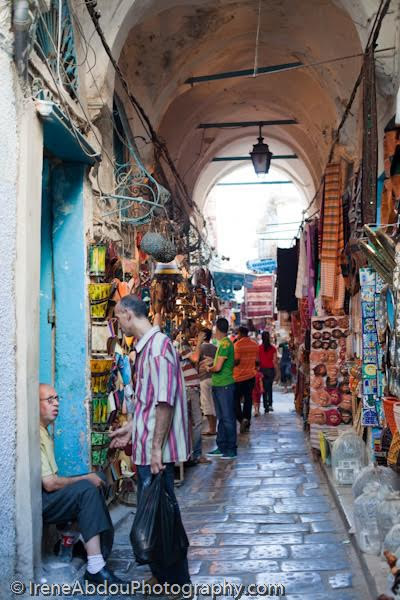
|
After a little practice, I find that some paths are lined with souvenirs and are walked more by tourists than Tunisians, whereas others are more populated by locals. The jewelry and clothing souk, selling used Western apparel, appears to be the most popular. Such was the mass of people that I can barely move on my own — I abandon myself to the crowd, which slowly carries me along. Groups of girls by three or four hold tightly to each others’ hands, creating a human chain that keeps them from being separated. But it was the dessert souk, selling sweat treats, that I find the most enchanting. Less crowded, the color and quality of the lights illuminating the tunnels create a surreal atmosphere. As I walk along, I also pause to look inside a café, where couples sit quietly to chat as some of the men smoke tobacco through long glass water pipes called chichas. Eventually, I come out into the open square of the Zitouna (Great Mosque) sits. On one side of the mosque sits the quaint stall of a bookseller. A tall man browses the books.
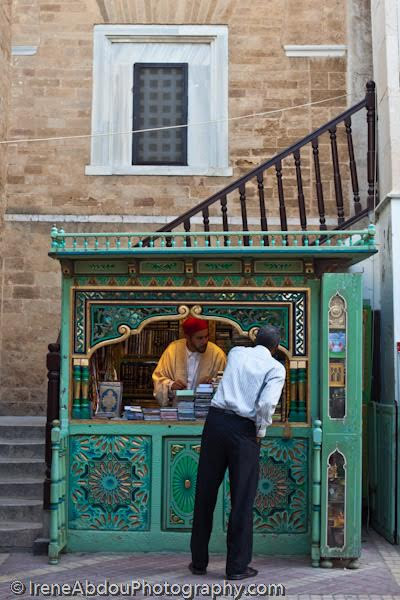
|
As the sun begins to set, I head back to Place de la Victoire, asking directions along the way, as I have already lost myself once again within the Medina. Reemerging from the ancient city, I head back along Avenue Bourguiba. Shortly after passing the cathedral, I come to the Theatre Municipal, a white stone building dating back to the French colonial period, which continues to offer plays, operas, and rock concerts. Groups of young men and women line the steps of the theatre, chatting as they watch the passersby. Next to the theatre, I walk up the steps to a café for dinner. As to be expected on Tunis’s Champs Elysees, the menu includes a mouth-watering selection of crepes, which turn out to be wonderful.
Not to be missed, before leaving Tunis, I also make sure to visit the legendary Roman port of Carthage, and its neighbor, a few kilometers to the south, of Sidi Bou Said, a charming seaside town of white-washed buildings with sea-blue doors. While Carthage is disappointing — little remains of its past Roman glory — I took solace in the fact that I will soon be heading south to the most beautiful Roman ruins of all Tunisia. So I allowed myself to enjoy meandering the stone-paved roads and steps that crisscross Sidi Bou Said and admire the varying designs of tall, arched wood doors decorated with iron studs.
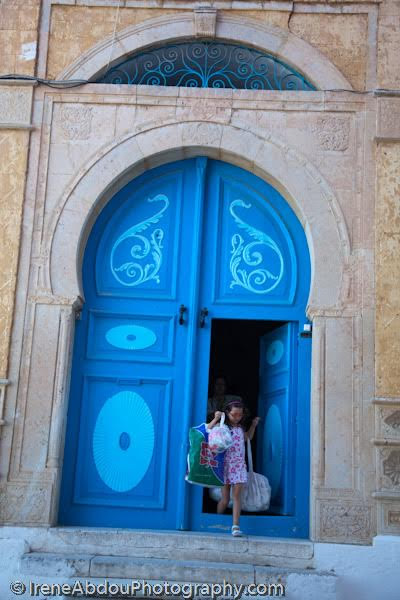
|
I also begin to practice some words of Arabic that I have picked up from taxi drivers and market vendors on my first day of wanderings - the greeting — “Keif al-haal” (how are you) — is the most difficult in terms of pronunciation. At first, I am frustrated, often repeating myself several times before being understood, but once the shopkeeper realizes that I am greeting him in Arabic, he teaches me a few new words and shows his delight for my efforts by offering me a small gift. One merchant gives me a “rose de sable” (sand rose), and another, a small, carved wood box. I am saddened how few tourists make the effort to learn even a single Arabic phrase or greeting.
Back in my hotel room, I chart my course south on the map. I would travel as far south as I could with a French-Panamanian-American couple who plan to rent a car — first 100 km southwest to Dougga, then another 75 km southwest through the mountains to Le Kef. Beyond that, I will have to see how it goes…how far I can get in just a few days.
Dougga is everything that Carthage is not. UNESCO World Heritage Site since 1997, and described in 1765 by an English traveler as “these magnificent remains of taste and greatness,” Dougga is the largest, most dramatic, and most beautiful Roman site in all Tunisia. Traveling at the end of June, the off-season, I have the benefit of scrambling over and through the vast ruins in seeming isolation — first, the magnificent theatre, then the capitol, and through the city.
It would have been a wonderful place to view the sunset, especially with its view over the serene farmland and orderly rows of olive trees below, but we do not have a lot of time and must continue moving forward. We drive down the winding slope towards town, pausing to greet two boys driving a herd of sheep and goats towards a watering area.
An hour or so later, we arrive in Le Kef, just 45 km from the Algerian border. The sun sets late in this area of the country, so after a late lunch, I head to the Kasbah (fort) — a legacy of various armed struggles dating back to the 1600s. The doorman is missing, so I ask a group of elderly men sitting nearby if I can enter. I push the little door within the big door open and find myself in an opening lined with a row of old canons.
After a few minutes, the doorman returns, only to inform me that the Kasbah is closed. It is past 7 p.m. Seeing my obvious disappointment, he graciously allows me to continue to explore, showing me all the nooks and crannies, along with the magnificent views from the top of the fort. “Al-maral khaadima,” I say, waving and smiling as I leave, pausing to chat with two locals who want to know where I am from and what I think of Le Kef. Absolutely beautiful, I respond without hesitation.
Walking down the broad stone road leading back to town, I come across a middle-aged woman and her elderly father, sitting on the cement steps leading up to the aqua blue door of their house. I stop to greet them - “Keif al-haal?” A flurry of Arabic follows — I reply “Mushketiir arabiiya shweya shweya” — I speak only a little Arabic. “Uwa mushketiir arabiiya shweya shweya,” the woman yells into the ear of her elderly father, who I deduce to be hard of hearing. We switch over to French, and the woman asks, with a slight tone of disapproval — “Are you here by yourself – you, a young girl?” I tell her that I am older than she thinks…and that I’m waiting for my friends. “She’s waiting by herself,” she bellows into her father’s ear, who she tells me is very fond of the French, having served in the French army for 20 years and spending quite a bit of time in France.
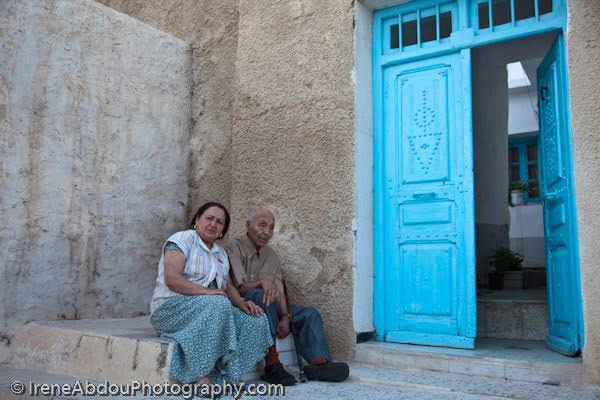
|
I continue down to the bottom of the steps, where I find a square graced by a large tree in the center, turrets of the mosque rising up behind, a café with outdoor tables on the two sides.
A few hours and 120 km later, we find ourselves in Kasserine. Not much here — a pit stop at best. But it’s already dark, so we check into the best and most expensive hotel in town, Hotel Amaïdra. For 20 Tunisian dinar a night — just US$15 — I lie down on the bed and drift into sleep.
The next day, the change in geography and vegetation becomes more and more remarkable. Less and less vegetation, more hardpan, vehicles few and far between, and views of nothingness all the way to the horizon. Five hours later, we pull into the town of Tozeur. After finally checking into a much more respectable hotel, not having eaten all day, we head first to le Petit Prince Restaurant, where the atmosphere and décor are charming. Wood pillars stud the restaurant, colorful lights shaped into rectangles, squares, and stars emanating from within the pillars.
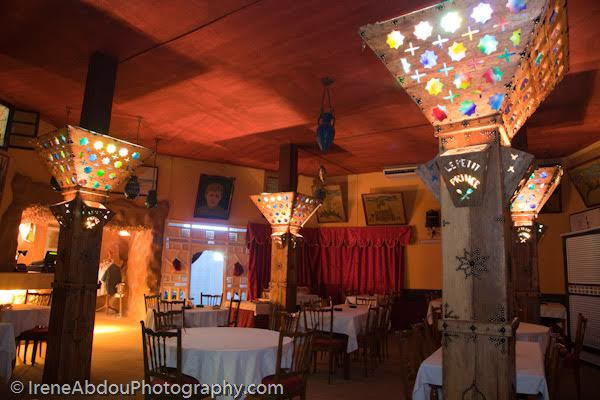
|
It is a bit sad that the restaurant is empty except for us and one other group. Like I said, off-season sure is quiet around here. We sit down to peruse the menu, and I am delighted by so many different couscous dishes. Finally! After a wonderful meal of couscous, lamb, and vegetables, we walk through the market area, where I pause to enter a shop selling carpets, tunics, and other Tunisian handicrafts. A group of men sit on the floor, leaning back on rolls of carpets, beer in hand and a pile of green — well — I did not know what — on a newspaper on the floor.
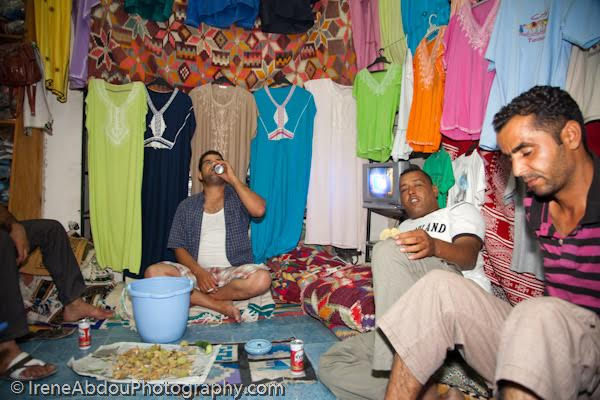
|
They offer me a seat and a handful of the green things, which turn out to be fresh almonds. I open up the green fruits and taste the almond within — soft, not at all like the hard nuts I know. Who would have known? I sit and chat with the men, who proceed to tell me that they like my kind of visitor — the ones with the backpacks and sneakers who do not mind sharing a meal with them. Indeed, this is my kind of travel. Getting to know the people is the best part of any trip.
The next day, I have only three places to visit on my agenda — the Dar Cherait Hotel, the oasis, and Ouled el Hadef quarter — as I would be catching the afternoon flight back to Tunis. The Dar Cherait is described in the Rough Guide’s book on Tunisia as “a lavish deluxe establishment…with sumptuous décor throughout.” Since I had already checked out the bottom end of the range, why not fulfill my curiosity about the top end? As I walk indoors, I am immediately impressed. First, the architecture — arched doorways and a view from the lobby of the magnificent domed ceiling two stories above.
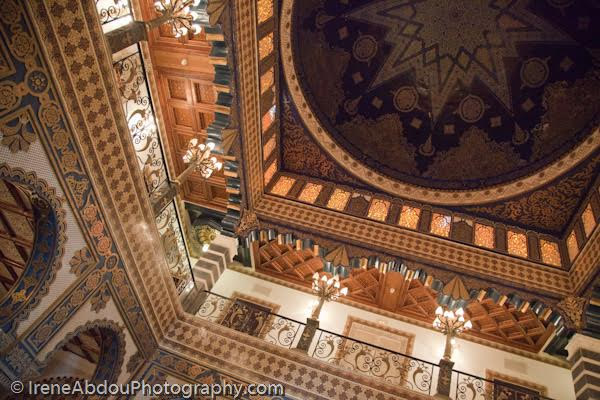
|
The second floor looks out over the lobby; the doors of the rooms framed or studded with small, reflective, square mosaic tiles. The exterior is just as magnificent as the interior. A beautiful tiled pathway is art in itself as it winds around to lead to a striking blue-domed gazebo, and the large swimming pool is framed by brick arches in the Tozeur style. The sauna’s tiled walls and arched doorways invite me inwards.
Ten square kilometers of some 200,000 palms, the drive through the Tozeur oasis is a stark contrast to the Dar Cherait Hotel. Leading from town through the oasis, the main dirt road is lined by Tozeur brick worked walls, with large wooden doors of the Tunisian variety providing occasional entry into the forests of palms. We pass an old brick mosque, unused and in disrepair, then a woman dressed in black, only her eyes and nose showing.
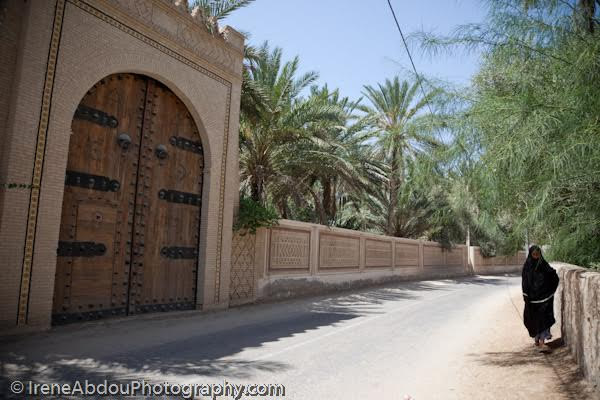
|
An hour later, we emerge from the oasis and head for Ouled el Hadef quarter. Dating back to the 14th century, the quarter is filled with narrow passageways along traditional Tozeur brick walls, occasionally passing through tunnels or opening into a square. The area is quiet, but my path occasionally crosses others — a man on foot, shirt unbuttoned, a man with a moped, and three men sitting in their doorways casually chatting. Eventually, I come to a square decorated by the ceramic wears of a handicrafts shop. Along a side street is a sign for a tea shop. I climb up the stairs and come out onto the roof of a house — a sea of mud brick buildings stretches out before me.
I enjoy the view, but my time is up. It is time to head back to Tunis, across the ocean, back home. The time is never enough.
Landing back in Tunis, I just have one more thing to do. I head back to the Medina for one last bit of shopping for a tunic — this will be my final souvenir of Tunisia. At Place de la Victoire, I enter a shop, and the shopkeeper pulls out various colors, sizes, and designs. And then, the bargaining begins. By now, I’ve learned the numbers — wahid, itniin, talaata, alarba, kamsa… — but they do not yet roll off my tongue. The shopkeeper helps me with my pronunciation. Back and forth we go. Finally, we agree on a price. He asks me where I am from, and I say that I am American. He is surprised. I hand him his money, but he gives some back to me. “For you,” he says. “Thank you for learning our language. Thank you for visiting Tunisia.” And I realize that my final souvenir is not a tunic, but a wonderful memory of the hospitality of the Tunisian people.
Irene Abdou is a travel/documentary photographer, now based in Germantown, Maryland, USA. Irene has lived and worked in Africa and Asia for over twelve years. Her first foray into a developing country was in the 1990s as a Peace Corps Volunteer in Niger. She recently returned from two years in war-torn South Sudan, where she lived in a tent for the entire two years.
|
